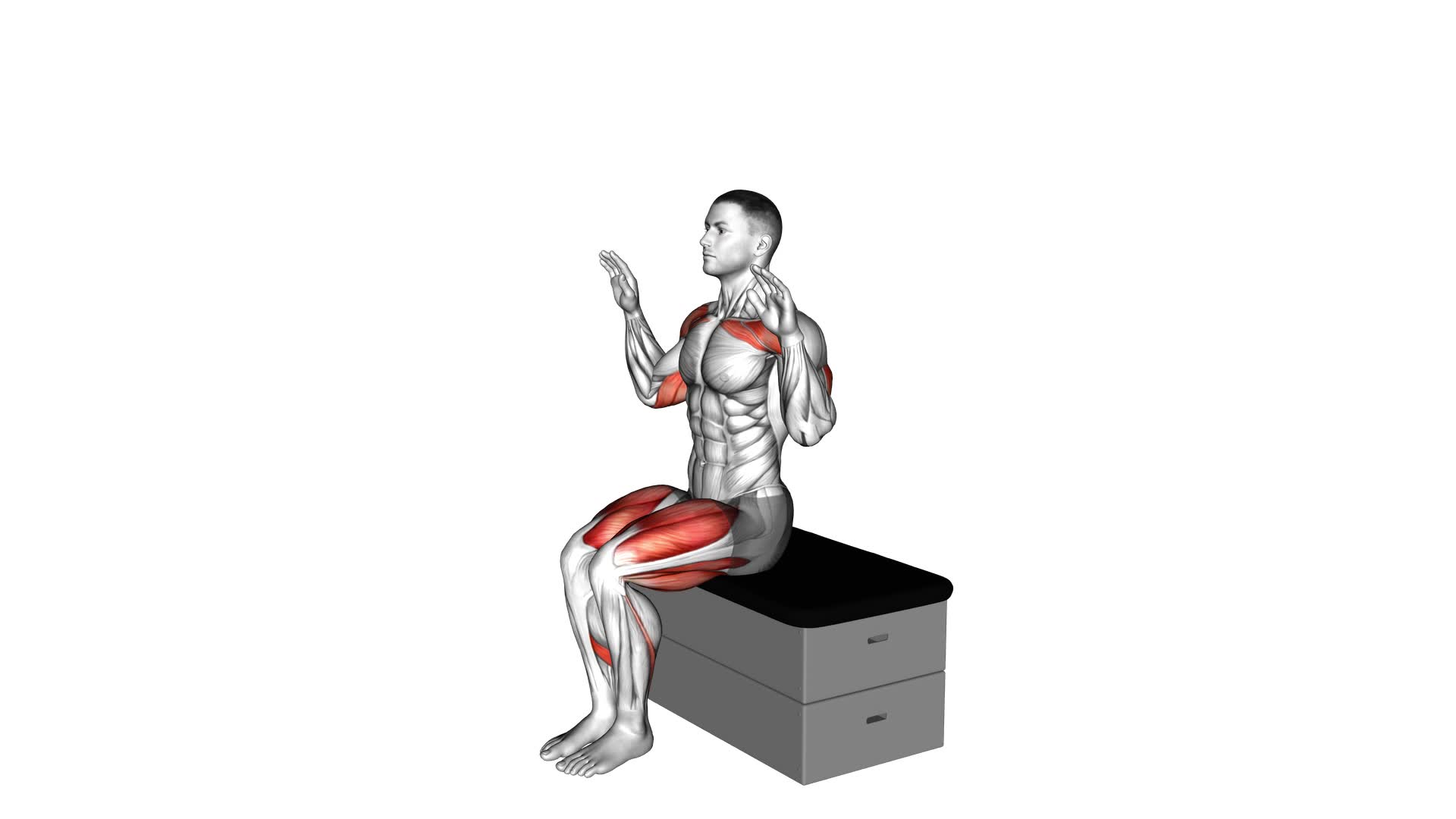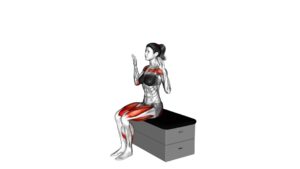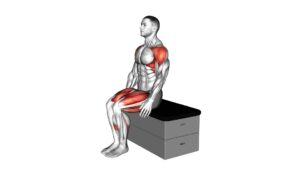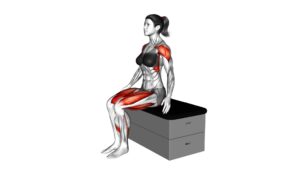Sitting Incline Press Stepout on a Padded Stool – Video Exercise Guide & Tips

Are you looking for a challenging exercise to strengthen your upper body and core? Look no further than the Sitting Incline Press Stepout on a Padded Stool!
Watch This Exercise Video
This exercise targets your chest, shoulders, and triceps while also engaging your abs. In this video exercise guide, we'll walk you through the proper form and technique, provide variations to adjust the difficulty level, and offer tips for maximizing effectiveness.
Get ready to take your workout to the next level!
Key Takeaways
- Improved upper body strength
- Increased stability
- Targets chest, shoulders, and triceps
- Develops a stronger and more defined upper body
Benefits of the Sitting Incline Press Stepout
The benefits of the Sitting Incline Press Stepout include improved upper body strength and increased stability. This exercise specifically targets the muscles of your chest, shoulders, and triceps, helping you develop a stronger and more defined upper body. By performing the Sitting Incline Press Stepout regularly, you can increase your overall strength and power, making daily activities easier and more manageable.
Additionally, this exercise helps to enhance stability in your core and lower body, as you must engage these muscles to maintain proper form throughout the movement.
Not only does the Sitting Incline Press Stepout offer physical benefits, but it can also contribute to improved posture and body alignment. By strengthening the muscles in your upper body, you can maintain a more upright posture, reducing the risk of back and shoulder pain. This exercise can also improve your overall body awareness and coordination.
Now that you understand the benefits of the Sitting Incline Press Stepout, let's delve into the proper form and technique for the exercise.
Proper Form and Technique for the Exercise
To perform the Sitting Incline Press Stepout with proper form and technique, follow these guidelines.
- Position yourself on a padded stool with your feet firmly planted on the ground.
- Place your hands on the handles of the resistance bands, ensuring a secure grip.
- Keep your back straight and engage your core muscles throughout the exercise.
- As you exhale, press the handles forward until your arms are fully extended.
- Pause briefly at the end of the movement, then inhale as you slowly return to the starting position.
It's important to avoid common mistakes when performing this exercise.
- One common mistake is using momentum to push the handles forward, rather than relying on your muscles to do the work.
- This can lead to ineffective results and potential injury.
- Another mistake is rounding your back or hunching your shoulders during the movement, which can strain your upper body and compromise your form.
If you're looking for alternative exercises that target similar muscle groups, you can try the seated chest press machine or the dumbbell chest press.
- Both of these exercises provide a stable base of support and allow you to focus on proper form and technique.
- Remember to consult with a fitness professional before attempting any new exercise to ensure it's suitable for your fitness level and goals.
Equipment Needed for the Exercise
For this exercise, you'll need a padded stool and resistance bands with handles. The padded stool provides a stable and comfortable surface for you to sit on during the exercise. It helps maintain proper form and ensures your safety while performing the Sitting Incline Press Stepout.
The resistance bands with handles are essential for adding resistance to the exercise and targeting your upper body muscles effectively. Using resistance bands with handles offers various benefits. First, they provide adjustable resistance, allowing you to customize the intensity of the exercise according to your fitness level. This makes the exercise suitable for beginners as well as advanced individuals.
Second, resistance bands engage multiple muscle groups simultaneously, including your chest, shoulders, and triceps. This helps improve upper body strength and muscular endurance. Third, incorporating resistance bands into your workout routine can enhance stability and balance, as they require you to engage your core muscles for stability during the exercise.
There are a few variations you can try with this exercise. One variation is to change the grip on the resistance bands. You can use an overhand grip, an underhand grip, or a neutral grip to target different muscles in your upper body. Another variation is to adjust the incline of the padded stool. Increasing the incline will make the exercise more challenging, while decreasing the incline will make it easier.
Additionally, you can try using different resistance bands with varying levels of resistance to continuously challenge your muscles and prevent plateaus in your progress.
Step-By-Step Guide on How to Perform the Sitting Incline Press Stepout
Now let's go through the step-by-step guide on how to perform the Sitting Incline Press Stepout, using a padded stool and resistance bands with handles. This exercise primarily targets the chest, shoulders, and triceps, while also engaging the core muscles for stability.
- Start by sitting on a padded stool with your back straight and feet flat on the ground. Place the resistance bands under your feet and hold the handles with an overhand grip.
- Lean back slightly, maintaining a neutral spine, and extend your arms straight out in front of you, keeping a slight bend in your elbows.
- Inhale and slowly press the handles outward, away from your body, until your arms are fully extended. Focus on squeezing your chest muscles throughout the movement.
- Exhale and slowly bring the handles back towards your body, maintaining control and resistance. Keep your elbows slightly bent to avoid locking them out.
- Repeat for the desired number of repetitions.
Common mistakes to avoid include using momentum to swing the handles, arching your back excessively, and not fully extending your arms during the press.
Remember to start with a light resistance band and gradually increase the tension as your strength improves.
Modifications and Variations to Challenge Yourself or Adjust the Difficulty Level
Looking to challenge yourself or adjust the difficulty level of the Sitting Incline Press Stepout on a padded stool? Here are some modifications and variations that you can try:
- Advanced Modifications:
- Increase the weight: If you find the exercise too easy, try using heavier dumbbells to challenge your muscles even more.
- Single-arm press: Instead of using both arms simultaneously, perform the exercise with one arm at a time. This will engage your core and stability muscles to a greater extent.
- Tempo variation: Slow down the lowering phase of the press to increase time under tension and make the exercise more challenging.
- Beginner Modifications:
- Decrease the weight: If you're just starting out or have limited upper body strength, start with lighter dumbbells or even no weights at all.
- Use a lower incline: If the stool's incline is too steep, try using a lower incline or even a flat bench to reduce the difficulty level.
- Perform the exercise seated: If standing is too challenging, you can perform the exercise in a seated position on the stool.
By incorporating these modifications and variations, you can tailor the Sitting Incline Press Stepout to your fitness level and continue challenging yourself as you progress.
Now, let's move on to some tips for maximizing the effectiveness of the exercise and avoiding common mistakes.
Tips for Maximizing the Effectiveness of the Exercise and Avoiding Common Mistakes
To maximize the effectiveness of the Sitting Incline Press Stepout on a padded stool and avoid common mistakes, focus on maintaining proper form and engaging the targeted muscles throughout the exercise. By following these tips, you can ensure that you're getting the most out of this exercise and avoiding any potential pitfalls.
One common mistake to avoid is using momentum to lift the weight. Instead, focus on a controlled and deliberate movement, using your muscles to lift the weight rather than relying on momentum. This will help to increase the intensity of the exercise and ensure that you're properly targeting the muscles you want to work.
Another mistake to avoid is arching your back or rounding your shoulders. This can put unnecessary strain on your spine and take away from the effectiveness of the exercise. Make sure to keep your back straight and your shoulders pulled back throughout the movement.
To increase the intensity of the exercise, you can try using heavier weights or increasing the number of repetitions. You can also slow down the movement to increase the time under tension, which will further challenge your muscles.
Remember to always listen to your body and adjust the intensity and weight as needed. By maintaining proper form and engaging the targeted muscles, you can maximize the effectiveness of the Sitting Incline Press Stepout and avoid common mistakes.
Frequently Asked Questions
How Many Sets and Repetitions Should I Do for the Sitting Incline Press Stepout?
To determine the number of sets and repetitions for the sitting incline press stepout, consider your fitness level and goals. Start with 2-3 sets of 8-12 repetitions and adjust as needed.
Modify the exercise by increasing or decreasing the weight, or adjusting the incline of the stool.
The sitting incline press stepout is beneficial for improving upper body strength and stability. It targets the chest, shoulders, and triceps while also engaging the core for balance.
Can I Use a Regular Chair Instead of a Padded Stool for This Exercise?
Yes, you can use a regular chair instead of a padded stool for the sitting incline press stepout. However, it's recommended to use a padded stool because it provides better support and stability during the exercise.
The padding helps to prevent discomfort and potential injuries. Additionally, the height of a padded stool is usually adjustable, allowing you to find the most comfortable position for your workout.
Is the Sitting Incline Press Stepout Suitable for Beginners or Is It More Advanced?
The sitting incline press stepout can be suitable for beginners with some modifications. It's a more advanced exercise that targets the upper body muscles, particularly the chest, shoulders, and triceps.
By using lighter weights and focusing on proper form, beginners can gradually build strength and improve their overall fitness level.
The benefits of the sitting incline press include increased upper body strength, improved posture, and enhanced muscle definition.
How Long Should I Rest Between Sets When Performing the Sitting Incline Press Stepout?
When performing the sitting incline press stepout, it's important to give yourself adequate rest between sets.
The rest duration can vary depending on your fitness level and goals. Generally, a rest period of 30-90 seconds is recommended to allow your muscles to recover and replenish energy.
However, you can modify the rest duration based on your preferences and needs.
Remember to listen to your body and adjust accordingly for optimal performance and progress.
Can I Incorporate Weights or Resistance Bands Into This Exercise to Make It More Challenging?
Yes, you can definitely incorporate weights or resistance bands into the sitting incline press stepout to make it more challenging. By adding weights, such as dumbbells or kettlebells, you increase the resistance and target your muscles even more effectively.
Resistance bands can also be used to provide a different type of resistance and help strengthen your muscles in a different way.
These variations can enhance your workout and help you achieve greater strength and muscle development.
Conclusion
In conclusion, the Sitting Incline Press Stepout is a beneficial exercise that targets the upper body and core muscles.
By following proper form and technique, using the necessary equipment, and making modifications as needed, you can effectively challenge yourself and adjust the difficulty level.
Remember to maximize the effectiveness of the exercise by following the tips provided and avoiding common mistakes.
Incorporate this exercise into your routine for improved strength and stability.

Author
Years ago, the spark of my life’s passion ignited in my mind the moment I stepped into the local gym for the first time. The inaugural bead of perspiration, the initial endeavor, the very first surge of endorphins, and a sense of pride that washed over me post-workout marked the beginning of my deep-seated interest in strength sports, fitness, and sports nutrition. This very curiosity blossomed rapidly into a profound fascination, propelling me to earn a Master’s degree in Physical Education from the Academy of Physical Education in Krakow, followed by a Sports Manager diploma from the Jagiellonian University. My journey of growth led me to gain more specialized qualifications, such as being a certified personal trainer with a focus on sports dietetics, a lifeguard, and an instructor for wellness and corrective gymnastics. Theoretical knowledge paired seamlessly with practical experience, reinforcing my belief that the transformation of individuals under my guidance was also a reflection of my personal growth. This belief holds true even today. Each day, I strive to push the boundaries and explore new realms. These realms gently elevate me to greater heights. The unique combination of passion for my field and the continuous quest for growth fuels my drive to break new ground.







